The AMD Ryzen 7 5800X3D Review: 96 MB of L3 3D V-Cache Designed For Gamers
by Gavin Bonshor on June 30, 2022 8:00 AM EST- Posted in
- CPUs
- AMD
- DDR4
- AM4
- Ryzen
- V-Cache
- Ryzen 7 5800X3D
- Zen3
- 3D V-Cache
Final Words
For users in the market for a new CPU designed to bolster frame rates in a gaming system, the AMD Ryzen 5800X3D is undoubtedly a powerful choice.
Even at $449, the Ryzen 7 5800X3D can perform as well, if not at times better than any chip from Intel's 12th Gen Core series of processors. The catch is that, as is often the case with new/unique technologies, the gains are uneven among games. This essentially means if the game doesn't benefit from the large 96 MB of 3D V-Cache onboard, it performs similar to the already existing Ryzen 7 5800X, which can be had for $350; $100 cheaper than the 5800X3D. In that respect, it would be helpful if AMD published a guide of games that they've found to materially benefit from the large L3 cache, just so gamers and users could decide whether the Ryzen 7 5800X3D is worth it.
The other angle is that, compared to the Intel ecosystem, the Intel Core i7-12700K for $380 represents a better buy in terms of all-around performance, where it has the advantage in most CPU compute workloads. So while the Ryzen 7 5800X3D has a niche it does quite well at, there's certainly an opportunity cost in getting this chip versus something that is a bit more rounded.
Let's dissect the performance across the different areas such as gaming and compute:
AMD Ryzen 7 5800X3D Analysis: Biased Towards Gamers
Looking at our data across our CPU testing suites (compute and gaming), the AMD Ryzen 7 5800X3D is a mixed bag. The Ryzen 7 5800X3D has an MSRP of $449 and represents a $100 hike over what the original Ryzen 7 5800X ($350) is currently selling for. Now let's dissect our analysis into two sections, gaming and compute, and piece it together.
AMD Ryzen 7 5800X3D Gaming Analysis: 3D V-Cache is Fantastic For Some Games (But Not All)
When AMD initially announced its Ryzen 7 5800X3D processor with its latest technological advancement in 3D V-Cache stacking, AMD made it clear that this processor was explicitly designed for gamers. The idea was that the additional levels of L3 Cache would play more to gamer's strengths with a larger buffer for more frequently used data instead of directly accessing it from system memory (DRAM). In gaming, a larger pool of L3 cache can indeed benefit and improve frametimes, as this data is closer to the CPU cores and is more quickly accessed by the individual cores from the processor as it would when accessing it from DRAM.
Now it's worth mentioning that in our testing, AMD's V-Cache-equipped chip didn't annihilate the competition in all of the games in our suite. Still, it certainly significantly impacted AMD-favored titles in its arsenal.
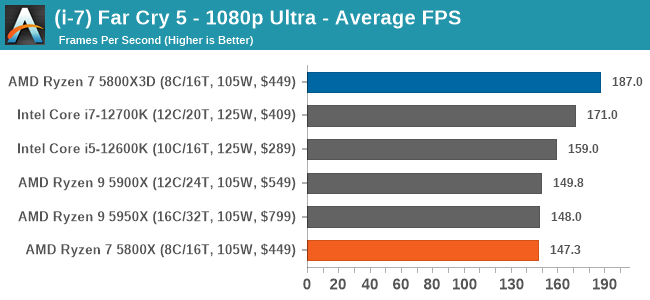
Looking at performance in Far Cry 5 at 1080p Ultra, which is notably an AMD partnered title, the AMD Ryzen 7 5800X3D with 96 MB of 3D stacked L3 Cache performed just under 27% faster than the previous AMD Ryzen 7 5800X processor. It was also around 9% better than the similarly priced Intel Core i7-12700K, which benefits from four more cores, higher IPC performance, and faster cores than the 5800X3D.
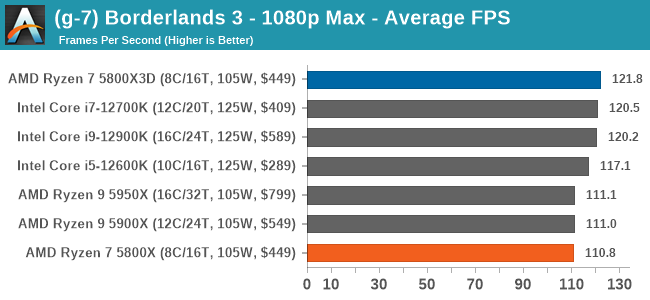
In Borderlands 3 at 1080p with maximum settings, the AMD Ryzen 7 5800X3D also topped our tables, even beating out the more expensive and premium Intel Core i9-12900K by over 1%, and beats all of the other Ryzen 5000 processors tested. This does give AMD some affirmation that its 3D V-Cache can push its technology as a win for gamers. Still, unfortunately, not every game title will benefit from massive levels of L3 Cache.
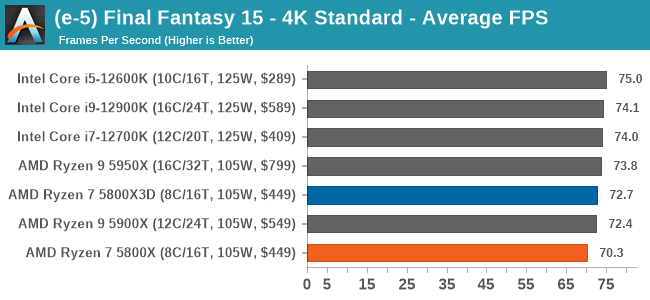
As for 4K gaming, there's not a lot to say here. This is almost always the realm of GPU-limited games, which limits the benefits a faster CPU can bring. Focusing on Final Fantasy 15 at 4K resolutions and using the standard preset, the 96 MB of L3 didn't have the desired effect on performance. The Ryzen 7 5700X3D does pull ahead, beating the previous Ryzen 7 5800X by around 3.4%, but it's small potatoes at this point.
AMD Ryzen 7 5800X3D Compute Analysis: Extra L3 Does Little For Compute Performance
While AMD pitched the Ryzen 7 5800X3D and its 96 MB of L3 cache as being beneficial in gaming, they didn't make the same kind of claims when it comes to applications and general compute performance. Because the benefits of a larger L3 cache are even more sporadic in these cases, AMD has wisely opted not to promote the part based on general compute performance here. Which is not to say that it's bad news for AMD, but as our data confirms, the L3 cache generally doesn't have much of an impact here.
It's worth noting that due to the 3D V-Cache, which is essentially 32 MB + 64 MB stacked vertically on top of each other using AMD's new chiplet packaging technology, AMD has had to be more conservative with core frequency to be in line with its 105 W TDP power rating. In comparison to the Ryzen 7 5800X, which has a base frequency of 3.8 GHz and a turbo core clock speed of 4.7 GHz, the Ryzen 7 5800X3D has a 400 MHz lower base frequency of 3.4 GHz, which its turbo core frequency is 200 MHz lower by comparison with a maximum core frequency of 4.5 GHz. This reduction in core frequency plays a key role in compute performance when directly comparing the 5800X3D and 5800X.
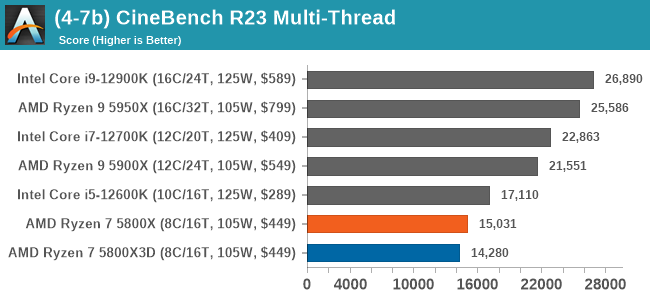
Looking at multi-threaded performance in Cinebench R23, the Ryzen 7 5800X3D performs 5.2% worse off than the existing Ryzen 7 5800X. This can be directly attributed to the differences in core frequency.
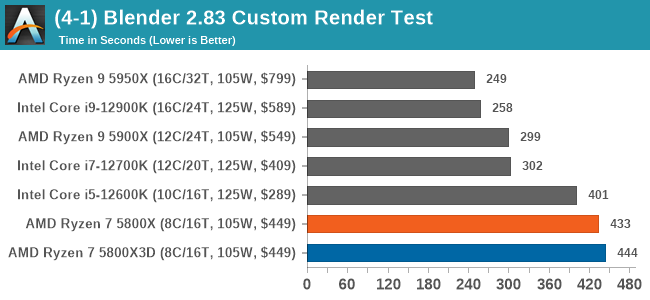
In our Blender 2.83 benchmark, the additional 64 MB of L3 cache on the Ryzen 7 5800X3D over the Ryzen 7 5800X made no difference in performance. Once again, the extra 3D stacked L3 V-Cache made no real impression on compute performance. With the critical sections of many non-gaming workloads either fitting within the confines of current L3 caches – or not fitting at all – there's no making up for more cores and higher clockspeeds most of the time.
AMD Ryzen 7 5800X3D is For Gaming, But Compute Performance is Average
Touted as the 'World's Fastest PC Gaming Processor' by AMD, this claim rings true in some aspects but not so much in others. The keyword in this claim is gaming, and it's true that the additional 64 MB of L3 cache does bring many benefits to the gaming market, albeit benefiting some games more than others.
The general outcome of our analysis is straightforward. If a specific title can benefit from a larger L3 cache, then the Ryzen 7 5800X3D and its 3D stacked V-Cache will prove very potent and fruitful to gamers looking to maximize frame rates. In situations where the game cannot benefit from the extra L3 cache, then the Intel 12th Gen Core series chips prove better with higher core clock speeds and higher IPC leading to higher overall performance.
The biggest benefits to gaming performance came in 720p and lower resolutions – which is to be expected since the CPU-limited scenario is something of a best case here – but the Ryzen 7 5800X3D at 1080p and 4K proved fruitful in selected titles. So even in workloads where the CPU isn't entirely free to run ahead of the GPU, it's clear that there's still some benefit to AMD's latest chip.
Otherwise, when it comes to raw compute performance, the Ryzen 7 5800X3D isn't as potent as Intel's 12th Gen Core processors – and in most of our computational-related tests, it also fell behind the vanilla Ryzen 7 5800X processor. This is because the L3 cache doesn't have as much of an influence on general purpose compute performance, and the Ryzen 7 5800X3D is clocked slightly lower due to voltage restraints (1.35 V) on the VCore.
Ultimately, It's pretty easy to make a case for the Ryzen 7 5800X3D as a solid gaming chip, especially as it decimates the competition in some titles. Just so long as potential buyers understand that the Ryzen 7 5800X3D is going to excel in gaming more than it excels in Excel. Otherwise, for users looking for a solid all-rounder capable of reasonable frame rates in gaming and reliable application and productivity performance, the Intel Core 12th Gen series has a little more oomph under the hood, albeit with a much higher power draw.
Performance matters aside, the Ryzen 7 5800X3D and its other V-cache ilk represent a massive step forward for AMD's engineering team. Stacking additional L3 cache is a novel way to expand the size of the L3 pool without significantly blowing up die sizes or resort to high-latency off-die caches, which gives AMD some important flexibility here to make such a part viable.
And clearly, AMD is happy with what they've accomplished as well. Along with the Ryzen chip, AMD has rolled out V-cache chips for enterprise and server products, where it is already playing a critical factor in performance. As a result, it comes as no surprise that AMD has confirmed that there will be 3D V-Cache products on its impending Zen 4 core (due fall 2022), and with Zen 5 which is expected sometime in 2024, with both consumer (Ryzen) and server (EPYC) products planned. So while all signs point to V-cache remaining a premium solution, it also means that we're far from done seeing what AMD can do for PC performance with larger L3 caches.


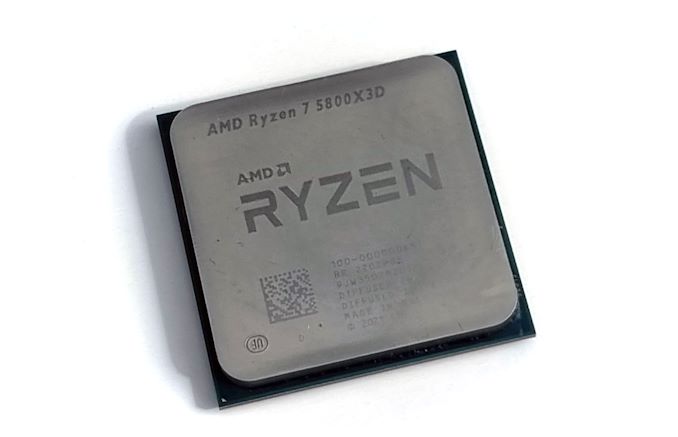








125 Comments
View All Comments
Stuka87 - Thursday, June 30, 2022 - link
Its not you, there is two full sets of them.Gavin Bonshor - Thursday, June 30, 2022 - link
Thank you, fixed 😊RBeen - Thursday, June 30, 2022 - link
Also does wonders for Planetside 2. I'm getting almost double the FPS from a 3600Xbrucethemoose - Friday, July 1, 2022 - link
Ah, the other game I wanted to see!Unsurprising, and it definitely needs all the CPU it can get.
bunkle - Saturday, July 2, 2022 - link
Nailed it. That's the biggest problem with all the games tested these days, they are single player games where CPU performance matters very little IMO.Games that are heavily CPU bottlenecked tend to be online FPS games with large player counts (~100) and lots entities to simulate such as Plantside 2 you mentioned and many Unreal Engine 4 titles: Hell Let Loose, Squad, Post Scriptum, Beyond the Wire, Holdfast Nations at War, Rising Storm 2: Vietnam, Squad, PUBG etc. to name but a few.
The problem is that it's very hard to reliably benchmark these games where it matters: in online gameplay without developer support. It's also where gaming has stagnated for the last 10-15 years. We have these amazing openworld maps that are completely barren with nothing happening in them and stuck with a limited number of players.
I realise that this isn't directly related to CPU performance and is also a software engineering challenge simulating world across multiple cores etc. but being able to showcase new CPUs and associated performance in these titles would probably help a lot with CPU marketing and would probably drive further innovation. Just look at UE5, theirs no mention of it's online capability or what new gameplay it enables, just more eye candy.
MadAd - Sunday, July 3, 2022 - link
Agreed, in an shooter like Planetside 2 the closer things like resist tables and default texture maps can be to the CPU the more fps can be gained on the graphic side. Having easily 200-300 players in a single fight over a base along with tanks, quads, troop transports and aircraft flying around you need the best single core processor you can get, which is why I switched to AMD with the 5 series and having more 3D cache just sweetens that pot.Slash3 - Thursday, June 30, 2022 - link
On page 5, it states memory used is DDR4-3200 CL40. I assume that's a typo, and that the usual JEDEC 3200 CL22 kit was used?Slash3 - Thursday, June 30, 2022 - link
Also, "insert analysis" at the bottom of page 7, and "DDR4-43200" at the top of page 8. ;)Glad to see the review up!
Gavin Bonshor - Thursday, June 30, 2022 - link
You are correct, was just a typoDevBuildPlay - Thursday, June 30, 2022 - link
Great article! I would love to see a similar article on the 3D cache differences on Epic under DB and other server workloads.